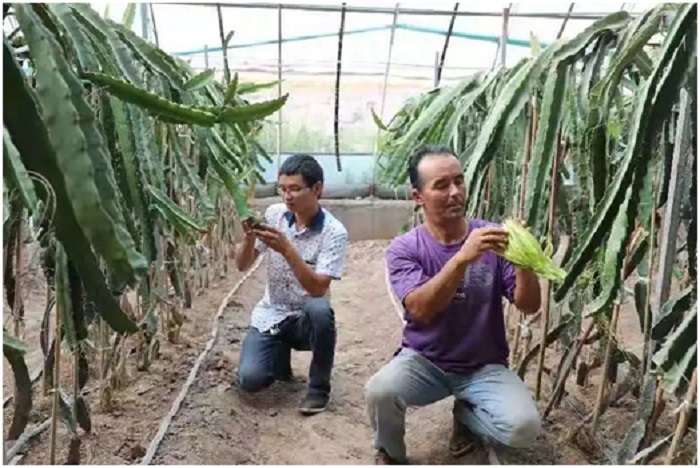



Poverty reduction efforts have paid off in a county on the southwest fringe of the Tarim Basin, China’s Xinjiang Uygur autonomous region, as the county pursues a path of agricultural and husbandry industrialization.
Keping county has 72.4 percent of its territory covered by the Gobi desert and mountains, and was once a priority on China’s poverty alleviation scheme. Developing industries that suit local conditions, the county has turned the table and embraced prosperity.
In Keping county’s Yu’erqi village, pitaya fruits are hanging on trees in greenhouses of a professional agricultural cooperative. These pitaya trees were introduced from southern China’s Hainan province.
“Pitaya fruits are fruits of money for us,” said Du Xiaoyan, an employee of the cooperative. She noted pitayas are easy to grow and manage, and feature low input and high output.
Upon market investigation, the cooperative started trialing the pitaya business since 2018. So far, 26 pitaya greenhouses have been built in Keping village, where over 10,000 pitaya trees are planted. The cooperative has 45 employees, including 39 impoverished, who can earn as much as 30,000 yuan ($4,594) each year.
Villager Memet Selam, receiving training from the cooperative, has planted pitaya trees in his vegetable greenhouses. His fruits are now sold under the assistance from the cooperative. “Each of my vegetable greenhouse could only make three to four thousand yuan a year in the past, but now the pitayas alone are earning me at least 30,000 yuan,” he told the People’s Daily.
The changes happening to Yu’erqi village is a miniature of Keping county’s poverty alleviation efforts.
In a camel shed in Klakuti village, 10 female camels are kept, together with several camel cubs. According to Zebirguli Mirz, who owns the livestock, she has 50 more in the mountain.
“Camel breeding is a tradition here, as camels are very adaptive to the dry climate in the Tarim Basin, and they seldom suffer from diseases,” said Wu Lin, deputy director of Keping’s department of agriculture and rural affairs, adding that camel breeding is taken as a major industry driving poverty alleviation in the county.
“Due to the lack of information and poor transportation, camels were kept by individual farmers. However, we are now actively industrializing the business, centralizing the livestock of minor herders and encouraging major ranchers to expand their stocks,” said the youngest son of Zebirguli Mirz.
According to him, Keping county now has a total of 9,200 camels, and is planning to introduce camel milk processing enterprises to increase the added value of the product and extend the industrial chain. He told the People’s Daily that his family can earn around 1,000 yuan per day from camel milk, which adds up to 200,000 yuan a year. In addition, his family can also gain an extra 10,000 yuan from camel hair business, he added.
Apart from camels, Keping county has also established a system that integrates leading sheep herding enterprises, major sheep ranchers and household sheep herders. It has built a sheep yard that currently has 4,000 rams on hand and over 13,000 slaughtered.
In Xingfu village of Achale township, Xinjiang Uygur autonomous county, new houses are standing in between asphalt roads, and Chinese national flags are hanging outside the houses.
“We didn’t have our own house before, so we had to rent one. The winds always blew dirt and ashes into the house, and the house also suffered from severe leakage,” said Lamet Deebai, a resident relocated to Xingfu village. According to him, his family now lives in a well facilitated 75-square meter concrete apartment, and the apartment was offered for free.
Lamet Deebai has grape trellis and a small vegetable plot in front of the apartment, and a livestock shed behind it. “We used to burn coals for heating in the winter, and now we have electricity, which is warmer and cleaner,” he said.
Former Party head of the village Aynur Memet told the People’s Daily that the village was established in 2017 for poverty alleviation, and a total of 499 impoverished residents were relocated there. It only cost a year to complete building the village, he added.
Some residents work near the village, while some work out-of-town. Every household has an employed member on average, and the per capita income growth stands at over 3,000 yuan.
After villager Tursunkar Ayeebu moved to Xingfu village, he and his wife started working for a textile company in Aksu city. The couple now earns 7,000 to 8,000 yuan per month. “We now have better house, and better income,” he said.
“I got rid of poverty the second year after moving here,” said resident Selamet Deebai. The man now earns over 20,000 yuan running a small shop each year, and his wife also earns similar amount working near the village. In addition, the couple also gain an extra of 10,000 yuan from land transfer every year. “It’s really great to be relocated here,” he told People’s Daily.
The per capita income of Keping county was 6,720 yuan in 2013, and rose to 11,185 yuan last year. The county officially bid a farewell to poverty in January this year.


The Executive and members of the.


The Acting Director, FCT Directorate of.


President Bola Ahmed Tinubu has been.



Barely a month after resignation of.


An Abuja based Legal Practitioner, Osuagwu.



Convener of Equitable Remedy, Mrs. Magaret.


Contractors handling the contract for city.


Nigerian government may have concluded plans.


The Diplomatic Correspondents Association of Nigeria.


A rights group, “Follow Me Talk.
Leave a Comment